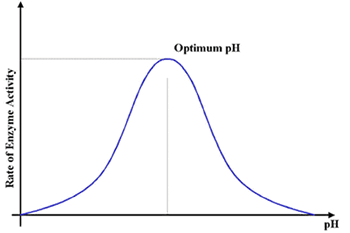Factors affecting Enzyme Activity
- The activity of an Enzyme is affected by its environmental conditions. Changing these alter the rate of reaction caused by the enzyme. In nature, organisms adjust the conditions of their enzymes to produce an Optimum rate of reaction, where necessary, or they may have enzymes which are adapted to function well in extreme conditions where they live.
Temperature
Increasing temperature increases the Kinetic Energy that molecules possess. In a fluid, this means that there are more random collisions between molecules per unit time.
Since enzymes catalyse reactions by randomly colliding with Substrate molecules, increasing temperature increases the rate of reaction, forming more product.
However, increasing temperature also increases the Vibrational Energy that molecules have, specifically in this case enzyme molecules, which puts strain on the bonds that hold them together.
As temperature increases, more bonds, especially the weaker Hydrogen and Ionic bonds, will break as a result of this strain. Breaking bonds within the enzyme will cause the Active Site to change shape.
This change in shape means that the Active Site is less Complementary to the shape of the Substrate, so that it is less likely to catalyse the reaction. Eventually, the enzyme will become Denatured and will no longer function.
As temperature increases, more enzymes’ molecules’ Active Sites’ shapes will be less Complementary to the shape of their Substrate, and more enzymes will be Denatured. This will decrease the rate of reaction.
In summary, as temperature increases, initially the rate of reaction will increase, because of increased Kinetic Energy. However, the effect of bond breaking will become greater and greater, and the rate of reaction will begin to decrease.

- The temperature at which the maximum rate of reaction occurs is called the enzyme’s Optimum Temperature. This is different for different enzymes. Most enzymes in the human body have an Optimum Temperature of around 37.0 °C.
pH - Acidity and Basicity
pH measures the Acidity and Basicity of a solution. It is a measure of the Hydrogen Ion (H+) concentration, and therefore a good indicator of the Hydroxide Ion (OH-) concentration. It ranges from pH1 to pH14. Lower pH values mean higher H+ concentrations and lower OH- concentrations.
Acid solutions have pH values below 7, and Basic solutions (alkalis are bases) have pH values above 7. Deionised water is pH7, which is termed ‘neutral’.
H+ and OH- Ions are charged and therefore interfere with Hydrogen and Ionic bonds that hold together an enzyme, since they will be attracted or repelled by the charges created by the bonds. This interference causes a change in shape of the enzyme, and importantly, its Active Site.
Different enzymes have different Optimum pH values. This is the pH value at which the bonds within them are influenced by H+ and OH- Ions in such a way that the shape of their Active Site is the most Complementary to the shape of their Substrate. At the Optimum pH, the rate of reaction is at an optimum.
Any change in pH above or below the Optimum will quickly cause a decrease in the rate of reaction, since more of the enzyme molecules will have Active Sites whose shapes are not (or at least are less) Complementary to the shape of their Substrate.

Small changes in pH above or below the Optimum do not cause a permanent change to the enzyme, since the bonds can be reformed. However, extreme changes in pH can cause enzymes to Denature and permanently lose their function.
Enzymes in different locations have different Optimum pH values since their environmental conditions may be different. For example, the enzyme Pepsin functions best at around pH2 and is found in the stomach, which contains Hydrochloric Acid (pH2).
Concentration
Changing the Enzyme and Substrate concentrations affect the rate of reaction of an enzyme-catalysed reaction. Controlling these factors in a cell is one way that an organism regulates its enzyme activity and so its Metabolism.
Changing the concentration of a substance only affects the rate of reaction if it is the limiting factor: that is, it the factor that is stopping a reaction from preceding at a higher rate.
If it is the limiting factor, increasing concentration will increase the rate of reaction up to a point, after which any increase will not affect the rate of reaction. This is because it will no longer be the limiting factor and another factor will be limiting the maximum rate of reaction.
As a reaction proceeds, the rate of reaction will decrease, since the Substrate will get used up. The highest rate of reaction, known as the Initial Reaction Rate is the maximum reaction rate for an enzyme in an experimental situation.
Substrate Concentration
Increasing Substrate Concentration increases the rate of reaction. This is because more substrate molecules will be colliding with enzyme molecules, so more product will be formed.
However, after a certain concentration, any increase will have no effect on the rate of reaction, since Substrate Concentration will no longer be the limiting factor. The enzymes will effectively become saturated, and will be working at their maximum possible rate.

Enzyme Concentration
Increasing Enzyme Concentration will increase the rate of reaction, as more enzymes will be colliding with substrate molecules.
However, this too will only have an effect up to a certain concentration, where the Enzyme Concentration is no longer the limiting factor.
